Speech Buffers and Options

Philip Lowe[*]
Governor
Committee for Economic Development of
Australia (CEDA) Annual Dinner
Melbourne –
It is an honour to be able to address CEDA's Annual Dinner. It became a tradition under the previous Governor, Glenn Stevens, to speak at these dinners about prosperity: what it looks like and how Australia might continue to secure it in the uncertain world in which we live. This is a tradition that I would like to continue.
I could understand why you might not have guessed that looking at the title of my remarks this evening: ‘Buffers and Options’. You might have feared that this was going to be an esoteric talk about finance. But that is not what I have in mind. Instead, I chose this title because it summarises the one element of securing prosperity that I want to focus on tonight. Glenn spoke in detail about the various things that we can do to lift our average growth rate. Rather than repeating these, I would like to focus on another element of the challenge. And that is managing risk and ensuring resilience.
To provide some context I would like to begin with two observations.
The first is that Australia's economic success over recent decades reflects both the underlying fundamentals and our ability to ride out various shocks. The fundamentals that have helped us are well known. They include our openness to trade and investment, our generally favourable demographics, our diverse and talented people, our abundance of natural resources, our ability to undertake structural reform to boost productivity and our links with the fast-growing Asian region. But also important to our prosperity is the fact that over the past quarter of a century, our economy has not been seriously derailed by economic shocks. After all, nothing undermines prosperity like a severe recession in which large numbers of people lose their jobs and see their wealth decline.
It is not as if there has been a shortage of shocks that could have derailed us. There was the Asian crisis, the bust of the US tech boom and the global financial crisis. We also experienced a once in a century surge in our terms of trade and the subsequent decline.
The point is that we have been able to ride out these and other shocks without too much difficulty. In part this is because of the flexibility of our exchange rate, monetary policy and the labour market. We have also avoided the build-up of large financial imbalances. But this resilience is also because when the shocks hit we have had buffers to absorb them. Because of these buffers, we had options that not all other countries have had.
The second observation is that today many business people tell us they feel the heavy weight of uncertainty. The long list of factors we hear includes: uncertainty about the transition in the Chinese economy; the future direction of technology; the political environment, both abroad and at home; the impact of high debt levels on future consumer demand; and uncertainty about where the extraordinary global monetary expansion will ultimately end. Understandably, when people feel uncertain, they sometimes feel that it's best to delay making decisions, especially if those decisions are difficult to reverse. We want to seek out more information before proceeding. We want to wait.
So, to draw these two observations together: Australians have managed pretty well over the past quarter of a century, but we feel a bit uncertain about the future.
In my view, despite the uncertainties, we should still be looking forward to the future with some optimism. Here in Australia, with our long track record of good economic growth and our demonstrated ability to adjust to a changing world, we have a set of advantages that not all countries have. Our collective challenge is to capitalise on those advantages. Ensuring a strong focus on lifting productivity is surely the key here.
As we work out how to do this, though, we obviously can't ignore the uncertainties. But neither can we let those uncertainties force us to retreat, to withdraw from the world. If we do this, then we, and our children, will be poorer as a result. Rather, we need to deal with, and prepare for, those uncertainties. This brings me back to the title of my remarks, ‘Buffers and Options’. Part of our preparation is to ensure that we have adequate buffers in place to deal with future shocks wherever they come from. These buffers provide us with options when challenges arise.
I would like to talk about buffers in three broad areas: the financial system, the fiscal arena and household finances.
Financial System
One area where it is particularly important to have adequate buffers is in the financial sector. The financial sector can either act as a cushion for adverse shocks or it can act as an amplifier. Which one it turns out to be depends upon how well the system is prepared to deal with bad events. If the system has skimped on liquidity and is carrying too little capital, then it is likely to amplify shocks. Conversely, if the financial system has adequate buffers, it is better able to support the economy in difficult times.
The aftermath of the global financial crisis is a good example of what can happen. This chart (Graph 1) shows how bank lending has grown – or in the case of Europe, contracted – since the financial crisis in 2008. Many banks in Europe and the United States simply did not have large enough buffers for the events that unfolded. Even today, capital levels remain an issue for some European banks. Insufficient capital means that some banks are constrained in their ability to provide finance and helps explain why banks have not taken advantage of the European Central Bank's offer to lend them money at an interest rate below zero. The European economy has suffered as a result. In the United States, the picture is more positive, partly because there were more successful efforts early on to rebuild the buffers in the system.
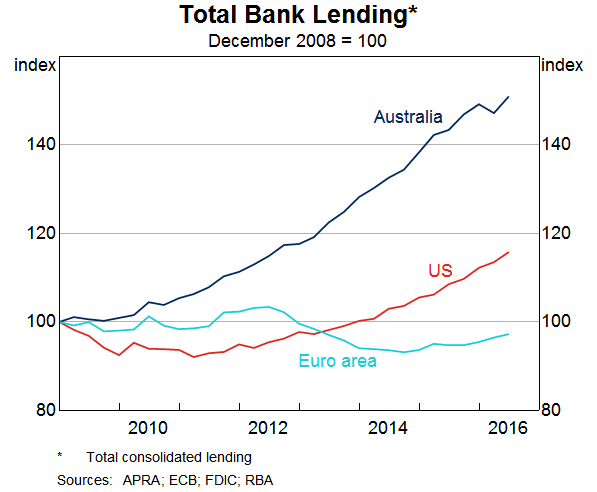
In Australia, it has been a different story. The banking system did have the capacity to support the economy during the global crisis, although it is important to point out that it did this with the assistance of the Australian Government through various guarantee schemes following the freezing of global capital markets.
Around the world, the experience of recent years has rightly caused banks and their regulators to think again about how large the buffers should be. And the answer has been that they should be larger than they were before. This has been true in Australia too, despite the starting point here being better than in many other countries.
Since the beginning of 2015, the major banks have raised around $28 billion from new equity and retained earnings, significantly increasing their capital relative to their assets (Graph 2). Banks are also holding a larger share of their assets in liquid form and have changed the composition of their funding towards more stable sources (Graph 3). During 2016, liquid assets have accounted for around 20 per cent of the major Australian banks' total assets, up from an average of around 15 per cent in the years preceding the financial crisis. Banks have also increased their use of deposits and long-term debt and reduced their use of short-term debt.

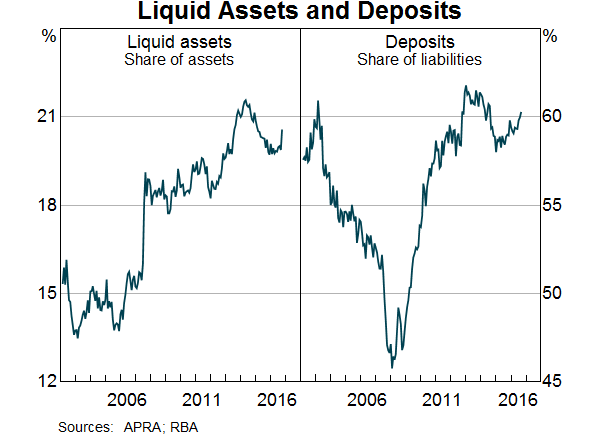
These are positive developments and they provide us with an extra degree of insurance against future shocks.
Of course, this insurance does not come for free. Higher capital, more liquidity and more expensive, stable funding all have a price. We need to keep an eye out to make sure that this price is not too high and that we don't constrain the ability of the financial system to do its job. My view is that this has not been the case in Australia and that the changes have increased the resilience of our system.
There is, though, a legitimate discussion to be held as to who pays the price. We see this issue frequently debated in our media. One possibility is that the cost falls on the bank shareholders in the form of lower returns on equity. Another is that it falls on borrowers in the form of higher interest rates on bank loans relative to the cash rate.
Ultimately, the balance is for the market to sort out, but it would seem unlikely that the cost will fall entirely on one side or the other. Over time, shareholders and borrowers will both benefit from these larger buffers to the extent that they contribute to economic stability. The shareholders should experience less volatile returns and borrowers should be more likely to be supported during difficult times. The larger buffers provide a form of insurance to all.
Fiscal Arena
A second area where buffers are important is on the fiscal front.
Again, the events of the past decade provide a useful illustration.
In Europe, we saw examples of what can happen when public finances are not in order when difficult times strike. In some countries, when troubles arrived, governments felt that they had little choice other than to impose austerity measures to restore the fiscal accounts, despite the fact that these measures added to the immediate downturn in the economy.
Australia, again, provides a counter example. When the shockwaves of the global financial crisis hit us, the Australian Government did have the capacity to support the economy through a fiscal expansion. This support was one of a number of factors that helped us get through this period. The ability to provide the stimulus was enhanced by the sound fiscal position that had been built up over previous years (Graph 4). While the exact nature of the stimulus remains a matter of debate, regardless of where you stand on that debate the fiscal buffers that we had did provide us with options that not all other countries had.
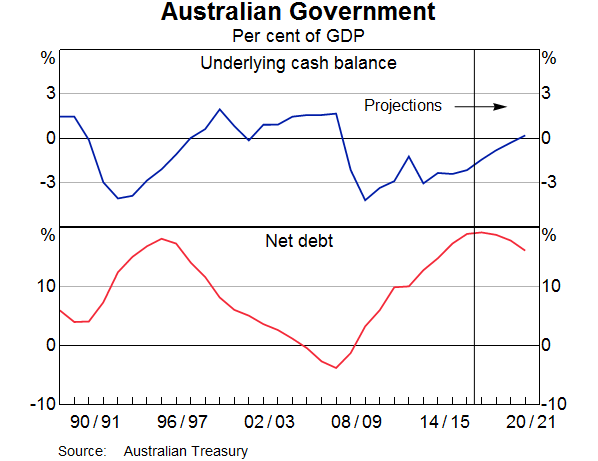
Since the financial crisis in 2008, the budget has been in deficit and debt levels have moved higher. Under current projections, net debt is expected to peak in 2017/18 at 19.2 per cent of GDP and a balanced budget is not expected until 2020/21. This would still leave the fiscal accounts in better order than those in many other countries. Importantly, this means that fiscal policy still retains capacity to support the economy in difficult times. But this capacity is less than it once was. We have a smaller buffer than we once did and a smaller buffer means fewer options.
So from a risk-management perspective, there is merit in rebuilding our buffers on the fiscal front. This is a task that can be undertaken over time and it requires difficult choices to be made. As Secretary to the Treasury John Fraser reminded us in a recent speech, the task is made more difficult by slow growth in nominal income.[1] But it is important that we ensure our public finances are on a sustainable track. This requires a better balance to be established, over time, between recurrent spending and revenue. It is worth pointing out that this does not preclude government spending on infrastructure, where this is backed by a strong business case. Such spending can provide support for the economy and can help generate the productive assets that a prosperous economy needs. Done well, infrastructure spending is not inconsistent with establishing a better balance between recurrent spending and revenue.
Household Finances
The third set of buffers that I would like to talk about are those in household balance sheets.
These buffers too are important as they influence how households respond to difficult economic times. Ideally, in such times, people are able to draw on their savings a bit, and perhaps even access credit, so that they don't have to cut their consumption sharply. Of course they can do this only if their balance sheets are in reasonable shape.
Again, overseas experience is relevant here. In the United States when the recession hit in 2008 some households found that they had simply borrowed too much. What followed was a period of defaults by some, less new borrowing and faster repayment of some debt. The result was a more severe downturn and a more protracted recovery than otherwise would have occurred.
Given this and other experiences, we need to pay close attention to household balance sheets here in Australia too. Debt levels, relative to income, are high in Australia and are much higher than they once were (Graph 5). Currently, household debt is equivalent to 185 per cent of annual household disposable income, a record high and up from around 70 per cent in the early 1990s. If we net off the household sector's holdings of cash and deposits the pattern looks somewhat different. It is important, though, to recognise that the households with the debt typically are not the same ones with the large deposits.
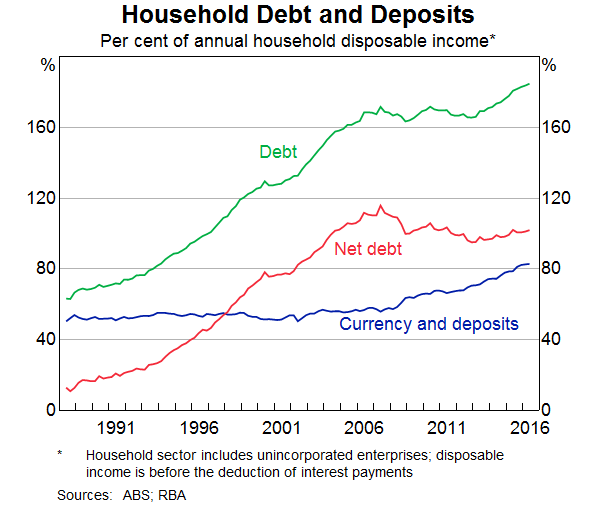
The reasons for the large increase in household debt have been well documented. The lower nominal interest rates that followed lower inflation in the 1990s allowed people to borrow more, as did the liberalisation of the financial system. As a nation, we took advantage of these new opportunities to borrow. As a result, we ended up with both higher levels of debt and higher housing prices.
Given the low level of interest rates and ongoing employment growth, most households are managing the higher levels of debt, but many feel that they are closer to their borrowing capacity than they once were and have adjusted their behaviour accordingly. Since the financial crisis, there has been a noticeable increase in the household saving rate. We are not using our houses like ATMs in the way that we were in the decade to the mid 2000s. Gone are the days when higher housing prices were a sign that we should go to the bank and borrow more to spend.
One illustration of this change in behaviour is the large increase in balances held in mortgage offset accounts and redraw facilities. In aggregate, households now have balances in these accounts equivalent to 17 per cent of total outstanding housing loans, which is a buffer worth 2½ years of scheduled repayments at current interest rates (Graph 6). From the survey data we look at, we can see that over recent years more households in all income brackets have got ahead on their mortgages (Graph 7).
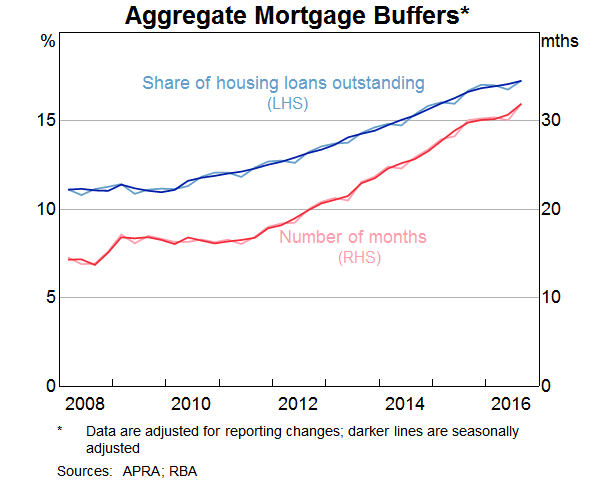
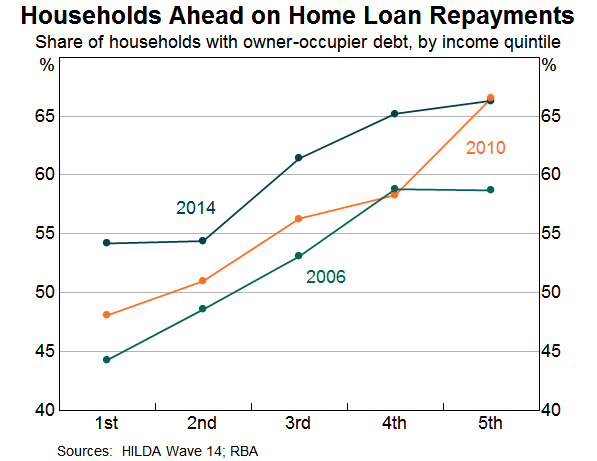
This more prudent behaviour is a positive development. Given the high and rising levels of debt, though, we need to watch things carefully. It is important that we avoid a build-up of financial imbalances in household balance sheets. We can never know with certainty exactly what level of debt is sustainable. It depends on income growth, lending standards and asset prices. But it surely must be the case that the higher is the debt, the greater is the risk. Given this, as I said recently when explaining our monetary policy decisions, it is unlikely to be in the public interest, given current projections for the economy, to encourage a noticeable rise in household indebtedness, even if doing so might encourage slightly faster consumption growth in the short term.
Conclusion
So in each of the three areas I have talked about this evening – the financial sector, the fiscal arena and household balance sheets – the story is broadly similar. Stronger buffers give us more options. And more options promote stability and prosperity. If we skimp on the buffers then we expose ourselves to more risk.
It is true that building these buffers does not come for free. In the financial sector, it might mean lower returns on equity or higher lending margins. In the fiscal arena, it means difficult trade-offs about recurrent spending and taxation. And in the household sector, it means consumption growth is slower for a time than it might otherwise be. But this is the nature of insurance. You pay a premium for protection against future uncertainties and to provide resilience. Of course, we need to make sure that this premium is not too high. But it is surely better to pay the insurance premium when the sun is shining than when the storm clouds are building or, worse still, to seek insurance when it is too late.
I am very conscious that this evening I have spoken a lot about providing resilience against future shocks. Before finishing, I want to point out that I am doing so not because we are predicting difficult times ahead. The Reserve Bank's central scenario for the Australian economy remains a relatively positive one.
Instead, my focus tonight probably reflects the inherent cautiousness of a central banker. Just as the past 25 years have seen numerous shocks to the global economy, chances are, so too will the next 25 years. In the past, we have been served well by the economy's flexibility and the buffers that we had. Being realistic, we will probably need these buffers again some time in the years ahead.
At the moment, though, our economy is adjusting better than many predicted to the unwinding of the mining investment boom. Over the next year, we are expecting the economy to grow at around its potential rate, before picking up a bit in the following year. We also expect some further modest progress in lowering unemployment, although spare capacity remains.
The low interest rates are helping to support the economy. And the decline in the exchange rate over recent years has assisted a number of industries. Survey measures of business conditions and consumer confidence generally remain above average. The prices for our commodity exports have also lifted since the start of 2016. As a result, for the first time in some years, Australia's terms of trade have moved higher. This will help to boost incomes and fiscal revenues.
Inflation remains low, but the latest reading did not suggest that it was moving lower still. There remain reasonable prospects that inflation will return to around average levels over the next couple of years.
Finally, to repeat an earlier point, despite the uncertainty in the world, we should be looking forward to the future with some optimism. Australians can continue to enjoy a level of prosperity enjoyed by relatively few people around the world. We have a strong set of fundamentals and a demonstrated ability to adjust to a changing world. We should also take some comfort that our system retains buffers against future shocks. Strengthening these buffers makes sense in the uncertain world in which we live.
Thank you.
Endnotes
I would like to thank Andrea Brischetto for assistance in the preparation of this talk. [*]
Fraser J (2016) ‘Australia's Economic and Fiscal Outlook’, available at <http://www.treasury.gov.au/PublicationsAndMedia/Newsroom/Speeches/2016/AGFIF-Tokyo>, Address to the Australian Government Fixed Income Forum, Tokyo, 21 October. [1]